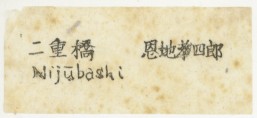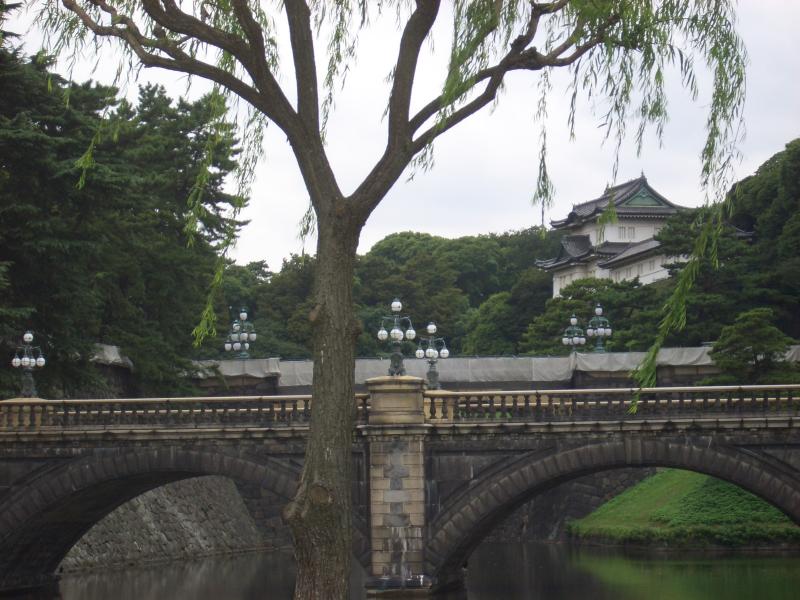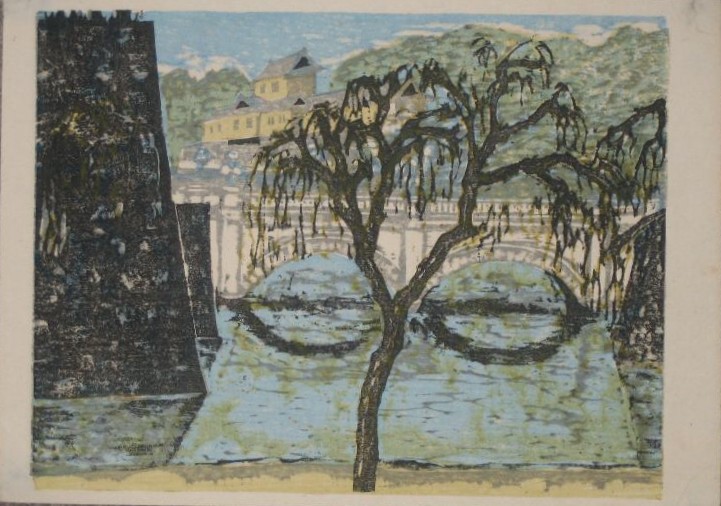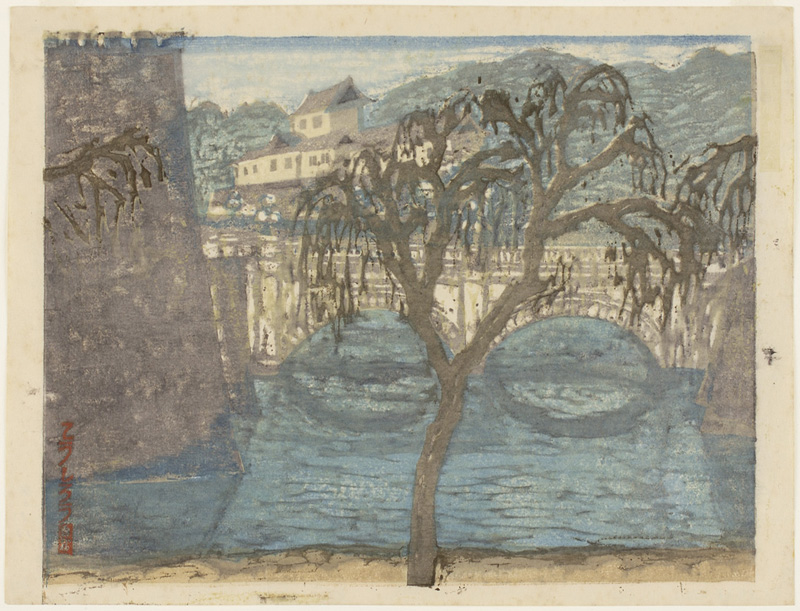About This Print
This print Nijūbashi is one of three contributed by Onchi Kōshirō (1891-1955) to the 15 print series Scenes of Last Tokyo (Tokyo kaiko zue), which he orchestrated. Originally issued in 1929 as part of the series One Hundred Views of New Tokyo (Shin Tôkyô hyakkei) this 1945 print was made from recut blocks. Nijūbashi is one of the six prints that Smith identified from the series Scenes of Last Tokyo as depicting "places with serious imperial resonances," the six being the Nijūbashi Bridge at the Imperial Palace, the Akasaka Palace (residence of the Crown Prince), the Meiji Shrine, the Torii (Gateway) at Kudan, the Gate of the Imperial University (alma mater of the most senior bureaucrats of the militarist era), and the Graveyard of Sengaku-ji, burial place of Japan’s most celebrated paragons of loyalty.

Original 1945 folder label of this print
二重橋 恩地孝四郎
Source: The Japanese Print Since 1900: Old Dreams and New Visions, Lawrence Smith, British Museum Publications Ltd., 1983 p. 87.
It was a lucky thing that Nijubashi, remaining so vividly in our hearts from our childhood as a revered object of worship, was not damaged. - Onchi Koshiro from the artist's statement accompanying the print portfolio Scenes of Last Tokyo (Tokyo kaiko zue).
Source: Terrific Tokyo: A Panorama in Prints from the 1860s to the 1930s, Elizabeth de Sabato Swinton, Worcester Art Museum, 1999. P. 72
Located in the heart of Tokyo, this double-arch stone bridge across the moat at the main entrance to the imperial palace at Nijubashi survived the Great Kanto Earthquake (of 1923.). Tourists, unable to enter the palace precinct, consoled themselves with a view of it from this perspective, on the southeast side of the bridge. Existing photographs, postcards, and prints produced from the time the bridge was built in 1887 attest to its importance as one of the "best sightseeing places in Tokyo.” Onchi places a willow tree in the foreground, obscuring our view of the bridge. The stone walls of the palace fill the left third of the design. Not interested in literal portrayal, the artist uses his carving of the blocks and color to create texture and capture an impression of the famous landmark.
Onchi made thirteen prints for the series One Hundred Views of the New Tokyo, three of which were reproduced from the original blocks in Scenes of Lost Tokyo. The artists had agreed to allow reissuing the prints for sale at the U.S. Army Post Exchange in Tokyo. Due to shortages after the war, the paper is quite different from that used for the originals, and the effect is consequently flatter and less vibrant than in the first state (seen below.)
from the series One Hundred Views of the New Tokyo (Shin Tokyo Hyakkei)
collection of Carnegie Museum of Art, 1029031

Print Details
| IHL Catalog | #169 |
| Title | Nijūbashi [Double Bridge to the Imperial Palace] 二重橋 |
| Series | Scenes of Last Tokyo [also seen translated as Recollections of Tokyo] 東京回顧図会 Tokyo kaiko zue |
| Artist | Onchi Kōshirō (1891-1955) |
| Signature | unsigned |
| Seal | none |
| Date | originally 1929 in the series One Hundred Views of New Tokyo (ShinTokyo hyakkei). Again in 1945 using recarved blocks for the seriesScenes of Last Tokyo (Tokyo kaiko zue) |
| Edition | 1945 (literature sometimes shows 1946 as publishing date) |
| Publisher | Fugaku Shuppansha 富岳出版社, Tokyo, Uemura Masurō 上村益郎 publisher |
| Printer | Hirai Kōichi 平井孝一 |
| Impression | excellent |
| Colors | excellent |
| Condition | good - thinned on top corners verso, with small tear and paper loss in top left-hand corner. |
| Genre | sosaku hanga (creative print) |
| Miscellaneous | |
| Format | chuban |
| H x W Paper | 7 7/8 x 11 1/16 in. (20 x 28.1 cm) |
| H x W Image | 7 3/8 x 9 5/8 in. (24.4 x 24.1 cm) |
| Collections This Print | Worcester Art Museum, Members’ Council Fund, 1987.79.1; Carnegie Museum of Art 89.28.709.9; British Museum 1980,1227,0.18.1; Mead Art Museum at Amherst College 2008.63.1; Allen Memorial Art Museum at Oberlin College 1999.1; Smithsonian Freer Gallery of Art and Arthur M. Sackler Gallery S1995.118.13; Portland Art Museum 1996.31.2a |
| Reference Literature | The Artist's Touch, The Craftsman's Hand: Three Centuries of Japanese Prints from the Portland Art Museum, Maribeth Graybill, Portland Art Museum, Oregon, 2011, p. 295; TerrificTokyo: A Panorama in Prints from the 1860s to the 1930s,Elizabeth de Sabato Swinton, Worcester Art Museum, 1999. p. 70; JapanesePrints During the Allied Occupation 1945-1952, Lawrence Smith, BritishMuseum Press, 2003 (see figure 41); Made in Japan – The Postwar Creative Print Movement, Alicia Volk, Milwaukee Art Museum, 2005, p. 35. |



